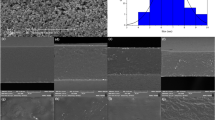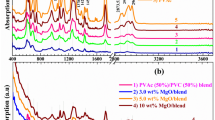Abstract
This work studies the UV protection properties of poly(vinyl-chloride) (PVC) nanocomposites. A functional property of UV protection is achieved by adding the active component (titanium dioxide (TiO2) or titanium dioxide modified with silver nitrate and copper nitrate) to the PVC matrix. PVC nanocomposites were prepared by extrusion and then pressed into films. Prepared PVC nanocomposites were characterized by thermogravimetric analysis, UV–Vis spectroscopy, X-ray diffraction and scanning electron microscopy. The mechanical properties and antimicrobial activity were also studied. The results show that PVC nanocomposites’ thermal stability is improved in relation to a pure PVC polymer. The thermal stability and antimicrobial efficiency increase when higher silver nitrate content is used. The sample prepared with silver and copper nitrate shows the best thermal stability due to a modified mechanism of thermal degradation. Samples where nanoparticles are homogeneously dispersed in the polymer matrix show good mechanical properties. The results also show that adding the active component TiO2 modified with silver ions contributes to the improved UV protection property of nanocomposite materials.











Similar content being viewed by others
References
Robertson GI (2012) Food packaging: principles and practice. CRC Press, USA
Silvestre C, Duraccio D, Cimmino S (2011) Food packaging based on polymer nanomaterials. Prog Polym Sci 36:1766–1782. doi:10.1016/j.progpolymsci.2011.02.003
Colin-Chavez C, Soto-Valdez H, Peralta E (2013) Diffusion of natural astaxanthin from polyethylene active packaging films into a fatty food simulant. Food Res Int 54:873–880. doi:10.1016/j.foodres.2013.08.021
Llorens A, Lloret E, Picouet PA, Trbojevich R, Fernandez A (2012) Metallic-based micro and nanocomposites in food contact materials and active food packaging. Trends Food Sci Technol 24:19–29. doi:10.1016/j.tifs.2011.10.001
Donlan RM (2002) Biofilms: microbial life on surface. Emerg Infect Dis 8:881–890. doi:10.3201/eid0809.020063
David SL, Hsuan YG (2003) Assessing the photodegradation of geosynthetics by outdoor exposure and laboratory weatherometer. Geotext Geomembr 21:111–122. doi:10.1016/S0266-1144(02)00068-7
Cheremisinoff NP (1997) Handbook of engineering polymeric materials. Marcel Dekker Inc., New York
Hussain I, Hamid H (2003) Plastics in agriculture. In: Andrady AL (ed) Plastics and the environment. Wiley, New York, pp 185–210
Murray CB, Norris DJ, Bawendi MG (1993) Synthesis and characterization of nearly monodisperse CdE (E = sulfur, selenium, tellurium) semiconductor nanocrystallites. J Am Chem Soc 115:8706–8715. doi:10.1021/ja00072a025
Reddy MK, Manorama VS, Reddy RA (2003) Bandgap studies on anatase titanium dioxide nanoparticles. Mater Chem Phys 78:239–245. doi:10.1016/S0254-0584(02)00343-7
Nussbaumer RJ, Caseri R, Smith P, Tervoort T (2003) Polymer-TiO2 nanocomposites: a route towards visually transparent broadband UV filters and high refractive index materials. Macromol Mater Eng 288:44–49. doi:10.1002/mame.200290032
Zhang Q, Gao L, Guo J (2000) Effects of calcination on the photocatalytic properties of nanosized TiO2 powders prepared by TiCl4 hydrolysis. Appl Catal B-Environ 26:207–215
Han K, Yu M (2006) Study of the preparation and properties of UV-blocking fabrics of a PET/TiO2 nanocomposite prepared by in situ polycondensation. J Appl Polym Sci 100:1588–1593. doi:10.1002/app.23312
Zhu H, Wu Y, Zhao X, Wan H, Yang L, Hong J, Yu Q, Dong L, Chen Y, Jian C, Wei J, Xu P (2006) Influence of impregnation times on the dispersion of CuO on anatase. J Mol Catal A-Chem 243:24–30. doi:10.1016/j.molcata.2005.08.021
Li Y, Peng S, Jiang F, Lu G, Li S (2007) Effect of doping TiO2 with alkaline-earth metal ions on its photocatalytic activity. J Serbian Chem Soc 72:393–402. doi:10.2298/JSC0704393L
Stern KH (1972) High temperature properties and decomposition of inorganic salts part B nitrates and nitrites. J Phys Chem Ref Data 1:747–772
Yang H, Zhu S, Pan N (2004) Studying the mechanisms of titanium dioxide as ultraviolet-blocking additive for films and fabrics by an improved scheme. J Appl Polym Sci 92:3201–3210. doi:10.1002/app.20327
Mo S-D, Ching WY (1995) Electronic and optical properties of three phases of titanium dioxide: rutile, anatase, and brookite. Phys Rev B 51:13023–13029. doi:10.1103/PhysRevB.51.13023
Zhang Y, Xiong G, Yao N, Yang W, Fu X (2001) Preparation of titania-based catalysts for formaldehyde photocatalytic oxidation from TiCl4 by the sol–gel method. Catal Today 68:89–95
Lattimer RP, Kroenke WJ (1980) The formation of volatile pyrolyzates form poly(vinyl chloride). J Appl Polym Sci 25:101–110. doi:10.1002/app.1980.070250110
Montaudo G, Puglisi C (1991) Evolution of aromatics in the thermal degradation of polyvinylchloride: a mechanistic study. Polym Degrad Stab 33:229–262. doi:10.1016/0141-3910(91)90019-N
Wilkie CA (2005) An introduction to the use of fillers and nanocomposites in fire retardancy. In: Le Bras M et al (eds) Fire retardancy of polymers: new applications of mineral filler. Royal Society of Chemistry, London, pp 3–15
Tyson BM, Al-Rub RKA, Yazdanbakhsh A, Grasley ZA (2011) Quantitative method for analyzing the dispersion and agglomeration of nano-particles in composite materials. Compos Part B-Eng 42:1395–1403. doi:10.1016/j.compositesb.2011.05.020
Wu S (1973) Polar and nonpolar interactions in adhesion. J Adhes 5:39–55. doi:10.1080/00218467308078437
Sinha Ray S, Okamoto M (2003) Polymer/layered silicate nanocomposites: a review from preparation to processing. Prog Polym Sci 28:1539–1641. doi:10.1016/j.progpolymsci.2003.08.002
Guo L, Yuan W, Lu Z, Li CM (2013) Polymer/nanosilver composite coatings for antibacterial applications. Colloids Surf A 439:69–83. doi:10.1016/j.colsurfa.2012.12.029
Fu G, Vary P, Lin CT (2005) Anatase TiO2 nanocomposites for antimicrobial coatings. J Phys Chem B 109:8889–8898
Daoud WA, Xin JH (2004) Low temperature sol–gel processed photocatalytic titania coating. J Sol–Gel Sci Technol 29:25–29. doi:10.1023/B:JSST.0000016134.19752.b4
Dastjerdi R, Montazer M (2010) A review on the application of inorganic nano-structured materials in the modification of textiles: focus on anti-microbial properties. Colloids Surf B Biointerfaces 79:5–18. doi:10.1016/j.colsurfb.2010.03.029
Grandcolas M, Yeb J, Hanagata N (2011) Combination of photocatalytic and antibacterial effects of silver oxide loaded on titania nanotubes. Mater Lett 65:236–239. doi:10.1016/j.matlet.2010.08.082
Rai M, Yadav A, Gade A (2009) Silver nanoparticles as a new generation of antimicrobials. Biotechnol Adv 27:76–83. doi:10.1016/j.biotechadv.2008.09.002
Jeong SH, Yeo SY, Yi SC (2005) The effect of filler particle size on the antibacterial properties of compounded polymer/silver fibers. J Mater Sci 40:5407–5411. doi:10.1007/s10853-005-4339-8
Yeo SY, Lee HJ, Jeong SH (2003) Preparation of nanocomposite fibers for permanent antibacterial effect. J Mater Sci 38:2143–2147. doi:10.1023/A:1023767828656
Lok C (2006) Proteomic analysis of the mode of antibacterial action of silver nanoparticles. J Proteome Res 5:916–924
Jeong SH, Hwang YH, Yi SC (2005) Antibacterial properties of padded PP/PE nonwovens incorporating nano-sized silver colloids. J Mater Sci 40:5413–5418. doi:10.1007/s10853-005-4340-2
Grace AN, Pandian K (2007) Antibacterial efficacy of aminoglycosidic antibiotics protected gold nanoparticles: a brief study. Colloids Surf A 297:63–70
Li Q, Chen SL, Jiang WC (2007) Durability of nano ZnO antibacterial cotton fabric to sweat. J Appl Polym Sci 103:412–416. doi:10.1002/app.24866
Souza VGL, Fernando AL (2016) Nanoparticles in food packaging: biodegradability and potential migration to food—A review. Food Packag Shelf Life 8:63–70. doi:10.1016/j.fpsl.2016.04.001
Acknowledgments
This work was financially supported in 2014 by the University of Zagreb, Croatia, through the Research Project PVC Nanocomposites with UV Protective Properties (TP1.29).
Author information
Authors and Affiliations
Corresponding authors
Rights and permissions
About this article
Cite this article
Krehula, L.K., Papić, A., Krehula, S. et al. Properties of UV protective films of poly(vinyl-chloride)/TiO2 nanocomposites for food packaging. Polym. Bull. 74, 1387–1404 (2017). https://doi.org/10.1007/s00289-016-1782-4
Received:
Revised:
Accepted:
Published:
Issue Date:
DOI: https://doi.org/10.1007/s00289-016-1782-4




